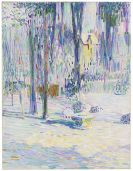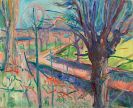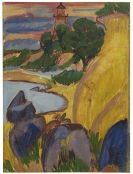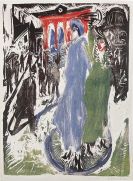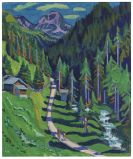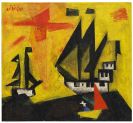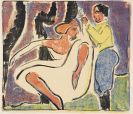
Curt Herrmann
Merseburg a.d. Saale
1854 -
Erlangen
1929
Hugo Curt Herrmann was born in Merseburg on the Saale on 1 February 1854. Without taking the examinations qualifying for university entrance, Curt Herrmann left school and in 1873 joined the studio of Carl Steffeck, who had numbered Max Liebermann and Hans von Marée among his pupils. Herrmann painted mainly portraits. After finishing his studies at the Munich Academy, where he had studied under Wilhelm von Lindenschmit from 1883, Curt Herrmann at first freelanced as a portraitist until moving to Berlin in 1893, where he opened a "Ladies' Drawing and Painting School", which he ran, with interruptions, until 1903.
Starting from Japonism, Curt Herrmann now became increasingly preoccupied with decorative painting and Jugendstil. In 1896/97 he met, probably through his wife, Henry van de Velde, with whom he would remain friends the rest of his life. Through van de Velde Curt Herrmann not only came into contact with Neo-Impressionism but also personally met such leading exponents as Paul Signac, Henri-Edmond Cross and Maximilien Luce and began to collect their work.
Curt Herrmann played an important role in the Berlin art scene, both as a painter and a collector. He was a founder-member and member of the board of directors of the "Secession" (1898) and the "Deutscher Künstlerbund" (1902) and, during the first world war, also president of the "Free Secession". His personal ties of friendship with Signac, van Rysselberghe, Denis and others made Curt Herrmann an influential spokesman for French Neo-Impressionism in Germany.
In 1906 Herrmann mounted a special exhibition under the auspices of the Berlin Secession featuring works by modern French artists. Curt Herrmann's own most active and productive period was between 1900 and 1912, when his motifs of choice were drawn from urban living. When he moved away from Berlin in 1923, he switched to flower painting.
Curt Herrmann was designated a professor of the Royal Academy of the Arts in 1917. In the occasion of his seventieth birthday, Curt Herrmann was treated to a comprehensive retrospective at the Kronprinzenpalais in Berlin in 1924. A private museum is dedicated to Curt Herrmann's paintings in Pretzfeld. A selection of his finest work is displayed there, notably paintings from his Neo-Impressionist period and many of the almost abstract flower paintings Curt Herrmann did at Pretzfeld.
Would you like to sell a work by Curt Herrmann?
Infos for seller
